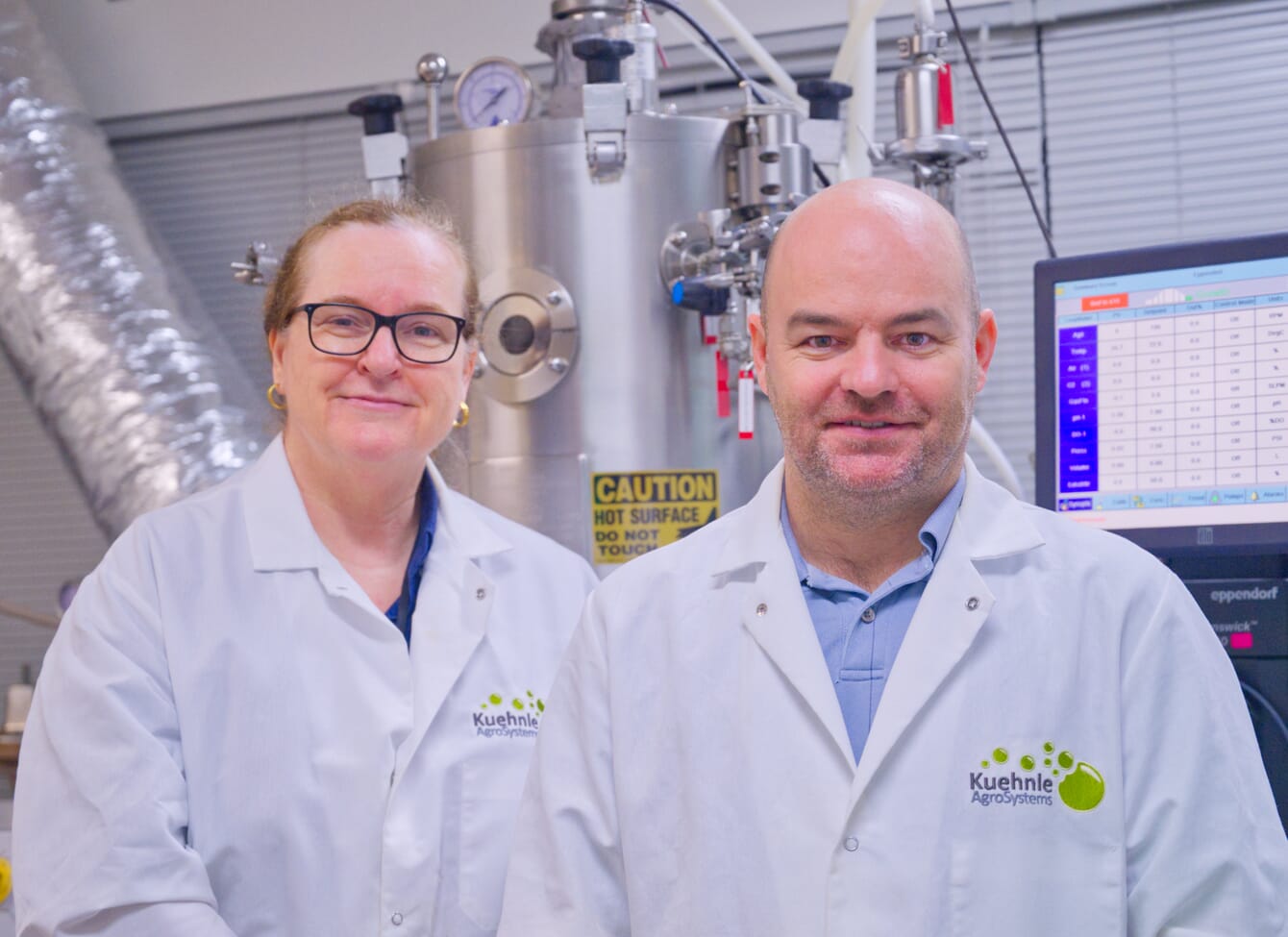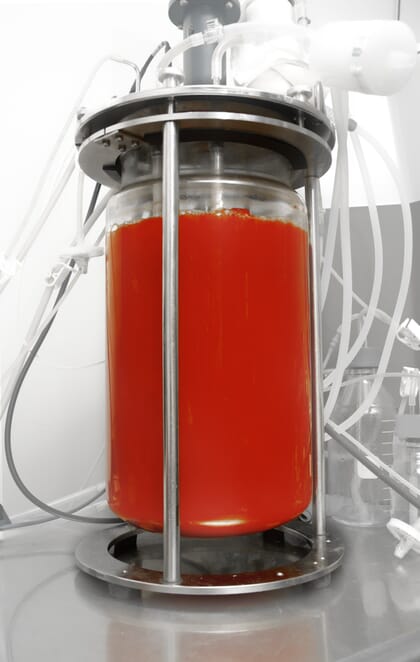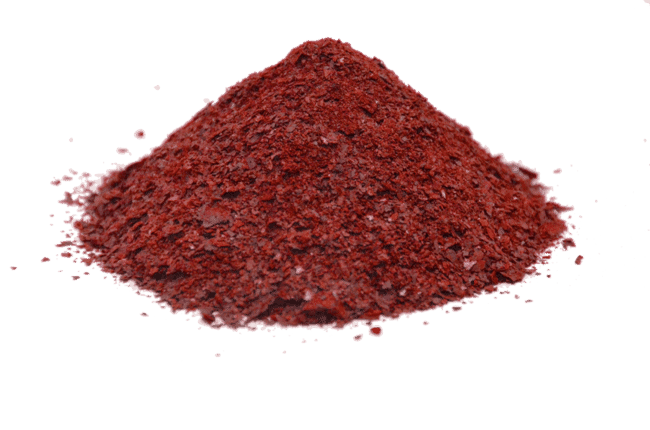
© Gordon Wallace
Here she explains her proprietary dark fermentation technology and why natural astaxanthin is such an important ingredient in aquafeeds – for so much more than its ability to influence the colouring of two of the world’s most popular forms of seafood.
Can you tell me a little about your background?
I come from a family of scientist/engineers with a history of entrepreneurship, innovation and discovery. After receiving a BA in biology from Middlebury College and a PhD in plant breeding from Cornell University, I went on to become a full professor in ornamental horticulture at the University of Hawaii. One specialty was in pigment biotechnology for tropical flowers, for which we used microalgae as a model system. During my tenure our team released over a dozen new flower varieties for global trade, including patented plant varieties with novel hues, and I co-authored numerous publications, including two books. I stepped away from academia to help drive microalgal business opportunities shortly after the company, Kuehnle AgroSystems (KAS)*, had been founded and had licensed some early technology.
Why did you decide to look into producing algae as a means of generating astaxanthin?
KAS was a subcontractor for algal-based biofuels projects for some years, doing algal strain development including for proteins as economic co-products. Algal oils for commodity biofuels failed to take hold, due to unsustainable costs. As a result, we saw the light and turned to dark fermentation as the path to best reduce costs of algae production and to open up more algal products to non-commodity applications. We chose a difficult but high value ingredient, astaxanthin.
Hawaii was already recognized as a source of highest quality astaxanthin from the alga, Haematoccocus, through its established nutraceutical industry. During KAS’s participation in the 2019 Hatch aquaculture business accelerator programme we focused on astaxanthin for fish feed. The powerful antioxidant pigment is delivered as a whole cell algal ingredient, not an extract. There was precedence for this as photosynthetic Haematoccocus already had proved efficacious as an animal dietary ingredient in the early days, before synthetic astaxanthin became widely adopted.
The challenge became that legacy autotrophic production technologies using raceways and photobioreactors were too costly and limited in volumetric capacity for supplying the aquafeeds industry; and nutraceuticals were much more lucrative.
Producing astaxanthin in the dark with aerobic fermentation was unheard of, yet the advantages of scale and economics were very attractive. We became even more motivated to succeed after spending time in Norway and Singapore on the Hatch programme, where we heard from numerous end-users that natural algal astaxanthin was clearly preferred over synthetic pigment, given the choice.
What are the main benefits of adding astaxanthin to aquafeeds – both from a fish health benefit and as far as consumers are concerned?
For today’s shoppers, colour is an important indicator of quality. Many consumers are unaware of synthetic colour being used in seafood, despite language of “Color Added” being mandated on labels in the USA. Synthetic astaxanthin is a petrochemical synthesised to substitute for natural astaxanthin found in microalgae in the food chain; it dominates the feed market in price and supply volume. Consumers crave real ingredients from nature, and we hope to deliver that.
Algal astaxanthin is thought to provide the best flesh/skin colouration via natural esterified pigments and phospholipids, according to recent literature (see Guerin M. 2019. Aquaculture Asia Pacific Jan/Feb vol 15:20-24.)
We believe that our natural astaxanthin product provides a means for feed manufacturers and vertically integrated operations to boost branding, deal with consumer backlash over using synthetic astaxanthin, demonstrate sustainability, and benefit from premium pricing in target markets.
Regarding animal health, there is value beyond colour using astaxanthin. Stress and disease are two main challenges in fish and shrimp aquaculture that benefit from the potent antioxidant activity of astaxanthin.
Who are your key customers likely to be?
Customers are feed ingredients suppliers, providers of formulated feeds, and also vertically integrated feed and fish operations. Examples include well-known industry names – such as Cargill, Skretting, Biomar, Kemin, ADM, Rangen, and Ridley – as well as for the ornamental fish trade and enthusiasts.
Where do aquatic organisms source astaxanthin in the wild?
Astaxanthin is naturally part of the food chain. It is found in krill for example and in several microbes. Haematococcus
is distinguished by being the highest producer found in nature, with well over 2 percent (dry weight basis) being typical.

© Gordon Wallace
Can you explain how your process works and how it differs from other astaxanthin producers?
Haematococcus is a photosynthetic microbe that normally needs light to grow. But it grows very slowly and is subject to culture failures due to weather, predation, and premature reddening in commercial production. Using our technology, we convinced the algae that they can grow more like a yeast than a plant cell when nurtured in the dark. We feed them a form of vinegar (acetic acid) that they metabolise into energy. The patent’s first named inventor, Robert Schurr, was brilliant in discovering a process that applied to a broader group of industrially relevant algae. Thereafter he also developed patent-pending high performing strains within the applicable algal taxa.
Through strain selection for Haematococcus - and also Chlamydomonas covered under the patent - we were able to get phenomenal growth rates and densities for volumetric yields, orders of magnitude higher compared to commercial raceways and photobioreactors. Just for illustration purposes, given the same starting point with unlimited capacity, one generates over 100x more biomass via heterotrophic growth than via photosynthetic growth after one week, and close to 900,000X more biomass after three weeks! Our strains are not mutated or genetically engineered.
Production of astaxanthin is accomplished within an accelerated time period of only hours for our method vs days and weeks for the photosynthetic route. This differs drastically from what is possible using legacy algae production technology, resulting in a product that is no longer cost-prohibitive especially for aquafeeds. In the process it protects natural resources by significantly reducing freshwater and land use compared to the photosynthetic route.
What’s the significance of your recent successful patent application?
Some say that the paradigm shift for producing algal astaxanthin in dark fermentation is akin to the breakthrough when algal omega-fatty acids (DHA and EPA) production shifted to dark fermentation. It enables much higher volumes and lower costs for a valued natural ingredient that spans market verticals (aquaculture, cosmetics, human health and well-being). It is also a platform technology; we have pipeline ingredients waiting in the wings.
What species have you trialled your astaxanthin on and what have been the results?
It has proved effective for pigmentation in salmonids and shrimp to date. This was using pre-commercial materials from the early days of our fermentation breakthrough, so we were quite pleased. We are very grateful to these companies for these first studies, but the data are proprietary so we cannot reveal specifics. Everyone is keen to repeat trials once product becomes available during scale-up for commercialisation, looking also for animal growth and vigour benefits for which algal astaxanthin is already recognised.
I could point out that Haematococcus microalgae have been historically very effective, based on the product called NatuRose, Haematococcus cracked cysts, used in many published tests with red fish [such as salmon and red sea bream], shrimp, and in white fish that receive premium pricing with colour. Customers are already familiar with algal astaxanthin and welcome attractive pricing enabled by fermentation production.
What feedback have you had from the aqua industry to date?
When our commercial director, Dr Claude Kaplan, joined the team a few months ago, he called industry leaders to hear directly from them regarding natural algal astaxanthin. The feedback has been unanimously positive. Currently there is a monopoly on natural astaxanthin, sourced from a mutagenised bacterium. Having choices will greatly benefit the aqua industry.
What percentage inclusion of astaxanthin is recommended in the diets of fish and shrimp?
There are standard recommendations for each animal as well as regional regulatory limits when Haematococcus or astaxanthin is used for pigmentation. Recommendations for salmonids, for example, for existing product is 50 to 80 ppm to meet colour grades specified for certain markets. It is possible that inclusion using our product can be lower, or applied post-extrusion or post-pelleting, items we plan to address in the future. [Further information is below.]
How much does it add to the production cost of a fish/shrimp?
Astaxanthin was accounting for 10- 15 percent of the feed cost for red fish around nine years ago. You will still see these numbers bandied about in the literature, and each operation is unique. But our own research indicates an effective dietary astaxanthin could do its job for a fraction of that, comprising less than 3 percent of the salmonid feed cost. Diets and feeding regimes have become quite sophisticated (more efficacious, lower usage of astaxanthin) and we anticipate lower costs as production volumes expand the available tonnage of natural astaxanthin.
The economic value for shrimp is interesting. The global shrimp feed sector was worth almost $5 billion in 2018. Our understanding is that use of formulated shrimp feeds containing astaxanthin is best for shrimp colour to meet market specifications, rather than relying on variable pond biota. Red shrimp fetch premium prices. Experts tell us this is the up and coming trend for premium shrimp into China as well as currently in Japan.
Published studies have shown that Haematococcus astaxanthin is preferred in shrimp, where it performs better than synthetic at lower doses. The algal astaxanthin differs chemically from the synthetic by being in a naturally esterified form that benefits some shrimp. Our rough calculations indicate that every 3 cents of KAS’s algal product potentially generates $3 more per kg shrimp wholesale, transforming light coloured shrimp into red shrimp to command premium pricing in a very competitive market.
We also speculate that the addition of our product to shrimp feed could be cheaper (potentially up to 80 times cheaper) and more sustainable than using black pond liners as a dark background colour for shrimp pigmentation in those regional centers of shrimp production that may not require pond liners.

© Gordon Wallace
Is the astaxanthin required throughout fish and shrimp production or purely in finishing diets?
Farmed salmonids and other red fish are fed formulated diets that include 50 – 80 ppm AX (50 - 80 g AX/tonne feed). Usage can be from juvenile through to mature fish. Depending on the species, the historically recommended use in shrimp is 75-100 ppm algal astaxanthin used 1-2 months before harvest, while today’s practice for some farms may be as little as 2-3 weeks prior to harvest.
Astaxanthin brings value beyond colour throughout the lifecycle. It is a highly potent antioxidant and anti-stress compound, with dozens of publications supporting efficacy in fish and shrimp. In salmonids dietary astaxanthin already benefits growth and survival of fry and even demonstrates pro-vitamin A functionality. In shrimp it is used in specialty feeds where other functions of astaxanthin are needed, such as in larval feeds or maturation diets.
Just to elaborate more on shrimp: disease and stress are the two significant industry challenges in shrimp production. Astaxanthin is deemed an essential nutrient to increase immunity to disease and overall survival and is especially important under stressful conditions such as occur with intensification of production. Higher quality feed that contains astaxanthin, and broodstock that are fed astaxanthin, are associated with increases in efficiency and productivity. Additionally, with the use of antibiotics in shrimp aquaculture being highly discouraged, a solution is needed to increase survival rate in face of bacterial infection. Astaxanthin (starting at 50 ppm) for example can counter early mortality syndrome (EMS) in vannamei shrimp, with improved shrimp survival rate if challenged by Vibrio parahaemolyticus through elevated immunity.
Publications show that astaxanthin improves vannamei shrimp resistance to stress conditions including low dissolved oxygen, low salinity, low temperature, and ammonia stress. Algal astaxanthin notably improves resistance and survival to white spot syndrome virus (WSSV). In Monodon shrimp, algal astaxanthin provides resistance to the low-salinity stress, and higher survival of larvae and post-larvae. Dietary astaxanthin benefits for kuruma prawn and for tiger prawn are also well documented.
How have you funded the company to date, and are you looking for further funding?
The company took in angel investment at the outset, and then for 10 years was self-sustaining through grants and client contracts. An example project was with the Chevron oil company in Hawaii, where we became the first algae company in the USA to be operational within the fence line of a working oil refinery. We designed and built an EPA-awarded demonstration project that routed CO2 emissions from the refinery to feed photosynthetic algae used in treating process water on site.
After taking part in the Hatch aquaculture business accelerator in 2019, the company obtained funding via convertible loan notes to take us to the current fund-raising effort. We are seeking US$1.5 million targeted to scale-up and commercialisation of the astaxanthin products. During 2020, advances in the technology reinforced the business value into a solid proposition: with our patented dark fermentation process we can make product better, faster and cheaper. It is a proven product with proven market demand; it is a high value and highly profitable product; and the patent protection positions the company for future manufacturing, be it with strategic partners or with its own factory.
What’s your current production capacity and what obstacles need to be overcome to scale up?
The KAS team has unleashed the biological potential of Haematococcus and Chlamydomonas (for proteins) using dark fermentation. Now that biology needs to be married with engineering capabilities found outside of our R&D labs, so in pilot fermentation facilities or with production partners, to advance rapidly towards commercial production.
*KAS and The Fish Site are both part of Hatch's portfolio, but we maintain editorial independence.




